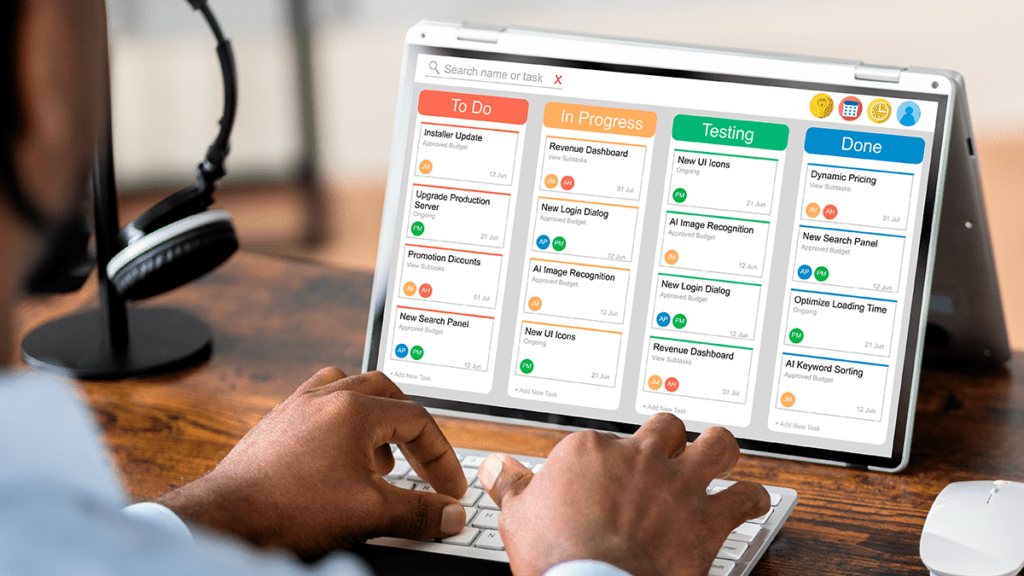OpenText™ Vendor Invoice Management for SAP® Solutions (VIM) is a leading invoice management and processing solution that fully integrates with SAP. The solution optimizes and automates end-to-end processing from receipt to posting using intelligent data enrichment, pre-configured rules, roles and actions. The product includes solutions for the Purchase to Pay and Order to Cash process as well as supporting any custom document processes.
Project methodologies have shifted from the classical waterfall model to a more agile project approach in recent years. In the context of VIM this allows for earlier and deeper involvement of business users and IT in their future document processing solutions. The benefit of increased involvement during implementation is an invoice processing setup perfectly tailored to the customer’s requirements and improved change management and adoption.
OpenText Professional Services project managers and consultants who implement invoice management projects have been able to use a methodology with an agile approach for years – the VIM for Invoice Processing FasTrak package provides a helpful framework for staying focused while remaining fully flexible and efficiently achieving the common goal using the agile methodology at the same time.
Let’s look at how an agile project approach benefits Vendor Invoice Management projects, using the scrum framework as an example.
A quick introduction to scrum
Scrum is a lightweight framework for creating solutions to complex problems. In increments, also known as sprints, which are commonly two weeks in length, the project team progresses toward a common goal. Short daily meetings with all team members ensure that everyone is on the same page and that blockages can be removed in an efficient manner. [1]
Sprint Planning
Sprint Planning is a collaborative meeting in Scrum where the team works together to determine what can be delivered in the upcoming sprint. The team chooses items from the product backlog, breaks them down into actionable tasks, estimates the effort, and makes the commitment to deliver an increment of the product by the end of the sprint. [2] This allows the whole team, including business users and consultants, to focus on single features with full attention instead of gradually processing many tasks in parallel. In a complex process such as invoice processing, it is essential that both the business has a comprehensive understanding of the solution, and the consultants have a comprehensive understanding of the business objectives.
Separating individual functions into user stories, prioritizing them, and discussing them at the appropriate time allows both sides to have the necessary understanding. The result is a solution that fits better to the needs and ensures the business users have a deeper understanding of what was set up for them.
Standup Meetings
Holding daily meetings, also referred to as standup meetings, with all team members helps ensure that everyone is aligned and working towards the product goal. [3] Besides sharing the status with everyone this also helps to identify and resolve impediments to progress early and quickly. This benefits the project from installation through to go-live as all topics, including the marginal ones, aren’t forgotten but can be discussed and resolved efficiently when every project member has the most recent information.
Sprint Review
Presentation of the sprint results after every sprint, invites early feedback from the project stakeholders. This ensures that the project team is heading in the right direction and a clear focus on the product goal is always present. [4]
In an example of one of Professional Services’ day-to-day projects at a large retail company, the stakeholders were very pleased when the invoice reduction feature was presented during one sprint review, but they noted that texts and layout must be adopted. Thus, the requirement was identified right after the implementation and in an early stage of the project and directly realized in the next sprint.
Sprint Retrospective
Retrospective meetings give the project team time to reflect at the end of every sprint. [5] In the appointment, each team member can share what worked well in the sprint and where there is still potential for improvement. Optimal collaboration is a key factor for project success.
The Professional Services team at OpenText has mastered the technology behind VIM to perfection and our business consulting is always at the forefront to make the most out of the powerful technology behind VIM. We support customers in the decision-making process by finding out together whether the product standard is suitable for the processes in their company or whether additional adjustments are needed in the project to achieve a made-to-measure solution.
While Vendor Invoice Management Projects were classically implemented using the waterfall project approach, the product and OpenText Professional Services methodology is one hundred percent compatible with using an agile approach utilizing all its benefits.
Interested in starting an agile Vendor Invoice Management project? Reach out to us!
[1] Schwaber, K. & Sutherland, J. (2020, November). The Scrum Guide. scrumguides.org. Abgerufen am 4. Mai 2023, von https://scrumguides.org/docs/scrumguide/v2020/2020-Scrum-Guide-US.pdf
[2] Schwaber, K. & Sutherland, J. (2020, November). The Scrum Guide. scrumguides.org. Abgerufen am 4. Mai 2023, von https://scrumguides.org/docs/scrumguide/v2020/2020-Scrum-Guide-US.pdf
[3] Schwaber, K. & Sutherland, J. (2020, November). The Scrum Guide. scrumguides.org. Abgerufen am 4. Mai 2023, von https://scrumguides.org/docs/scrumguide/v2020/2020-Scrum-Guide-US.pdf
[4] Schwaber, K. & Sutherland, J. (2020, November). The Scrum Guide. scrumguides.org. Abgerufen am 4. Mai 2023, von https://scrumguides.org/docs/scrumguide/v2020/2020-Scrum-Guide-US.pdf
[5] Schwaber, K. & Sutherland, J. (2020, November). The Scrum Guide. scrumguides.org. Abgerufen am 4. Mai 2023, von https://scrumguides.org/docs/scrumguide/v2020/2020-Scrum-Guide-US.pdf



